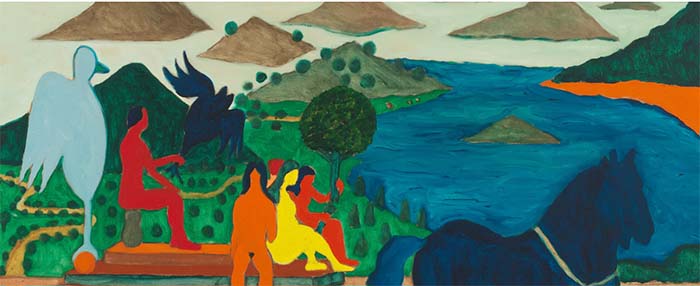밥 톰슨 개인전 Bob Thompson: So let us all be citizens @데이빗 즈워너 갤러리(4/21-7/8)
글로벌 파워 화랑 데이빗 즈워너 갤러리 뉴욕(52 Walker St.)에서 흑인 표현주의 화가 밥 톰슨(Bob Thompson, 1937-1966) 전시 'Bob Thompson: So let us all be citizens'가 열린다. 켄터키주 루이빌에서 태어난 밥 톰슨은 보스턴대 입학해 흑인 추상 조각가 샘 길리엄(Sam Gilliam)과 교제했으며, 프로빈스타운에서 작업했다. 1959년경 뉴욕으로 이주한 후엔 오네트 콜만, 소니 롤린스, 니나 시몬 등 재즈 뮤지션들과 어울렸다. 1966년 28세에 이탈리아에서 맹장염으로 사망했다.

Image: Bob Thompson, An Allegory, 1964. Whitney Museum of American Art, New York; gift of Thomas Bellinger 72.137. © Michael Rosenfeld Gallery LLC, New York, NY
Bob Thompson: So let us all be citizens | New York | David Zwirner
Location: 52 Walker, New York, 10013
Dates: April 21—July 8, 2023
52 Walker is pleased to announce its seventh exhibition So let us all be citizens, which will feature a range of paintings by Bob Thompson. The works on view spotlight the artist’s jazz-influenced style and how he used this method to engage new audiences within the history of painting. Looking at his particular consideration for color, line, and figuration—developed during a period when abstraction was the dominant trend in American art—this intimate exhibition pays homage to the friction Thompson generated between his proximity to and deviation from cited and canonical sources. The show’s title is taken from a speech that Thompson gave at a church as a teenager, “Building through Citizenship.” Forecasting the artist’s passion for the tenets of freedom and expression, the phrase “So let us all be citizens” encapsulates the power of Thompson’s work to widen the scope of what is imaginable in contemporary painting and for whom.
Though his career as a painter spanned only a brief eight-year period, from 1958 through his untimely death at age twenty-eight in 1966, Thompson left behind a singular and influential body of figurative work that remains vitally resonant. Taking cues from the exploratory and improvisatory music with which he was engrossed, the artist painted spirited, colorful compositions that considered the interplay of bodies, allegories, and natural landscapes while reconfiguring European masterworks. Including paintings from important public and private collections, this solo presentation at 52 Walker will be one of the first in New York City devoted to Thompson since his retrospective organized by the Whitney Museum of American Art in 1998.
From the late 1950s onward, Thompson incorporated classical and art-historical references into his visual language. Early works by the artist, Wagadu (1960) and Untitled (1961), feature his confident linework and flat planes of color; the former’s namesake references the Arabic term for the ancient Ghana Empire. The Ascension-like composition of Caledonia Flight (1963) is enlivened by fantastical creatures and its red-purple palette. The Gambol (1960), based on Paul Gauguin’s Where Do We Come From? What Are We? Where Are We Going? (1897–98), is another example of Thompson’s dynamic figuration, showing the artist exploring brushwork by layering quick strokes across the canvas and juxtaposing dark colors—a signature of this early period.
Bacchanalia, a prominent theme for renaissance and European modernist painters, also became a significant subject for Thompson from 1960 onward. Triumph of Bacchus (1964) references this topic explicitly and shows a “processional” composition—a hallmark of Thompson’s later work—loosely based on history paintings akin to those by the French baroque artist Nicolas Poussin. Alongside Paolo Uccello, Giorgione, Tintoretto, Jean-Antoine Watteau, and Francisco de Goya, Poussin was a looming influence for Thompson in his mature period, and he would derive and combine much of these artists’ compositions for his own. La Mort des Enfant de Bethel (1964–1965) takes its title from a seventeenth-century baroque Laurent de la Hyre painting and recasts the original composition into a more naturalistic setting—albeit with a vibrant, high-contrast palette.
Bob Thompson: So let us all be citizens is curated by Ebony L. Haynes and presented by 52 Walker. A companion group exhibition, So let us all be citizens too, which considers Thompson’s influence on both his contemporaries and subsequent generations of artists, will be on view concurrently at David Zwirner London. Michael Rosenfeld Gallery, which represents the estate of the artist, will also have a Bob Thompson solo exhibition in New York that opens on April 1, 2023.
Born in Louisville, Kentucky, Robert “Bob” Thompson (1937–1966) first entered Boston University to study education before leaving for the University of Louisville to pursue art in 1957. There, he met painter Sam Gilliam and joined the more established artist’s collective Gallery Enterprises. After his sophomore year, Thompson spent a summer painting in Provincetown, Massachusetts, where he encountered Lester Johnson and Jan Müller, whose work Thompson particularly admired.
Around 1959, Thompson moved to New York, where he mingled with jazz musicians Art Blakey, Ornette Coleman, Milford Graves, Sonny Rollins, and Nina Simone, among others. He also encountered Allan Kaprow’s Happenings as well as other developments in conceptual art; however, the artist would eschew these experimentations to engage more intimately with works by the established masters of European art history. After mounting his first solo exhibition in New York at Red Grooms’s Delancey Street Museum in 1960, Thompson received a grant to go to Europe; he would travel to and settle in Paris, Ibiza, and Rome for short periods of time, viewing works of art at museums and galleries firsthand while maintaining his studio practice. He returned to New York in 1963, joining Martha Jackson Gallery and presenting solo shows there in 1963 and 1965. He traveled to Rome in 1965. Despite warnings from his doctors and loved ones, Thompson continued to drink and use drugs heavily after an emergency surgery. After being hospitalized for appendicitis, he died in Italy at the age of twenty-eight in 1966.




 2023 트라이베카 영화제(Tribeca Film Festival, 6/7-18) 라인업
2023 트라이베카 영화제(Tribeca Film Festival, 6/7-18) 라인업


